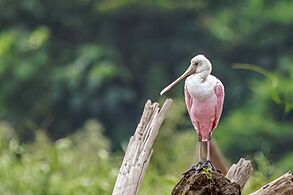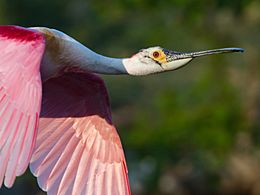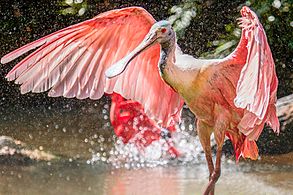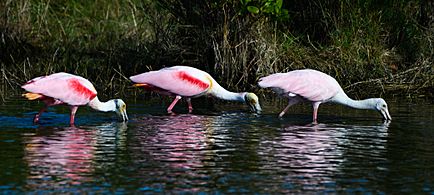Roseate spoonbill facts for kids
Quick facts for kids Roseate spoonbill |
|
|---|---|
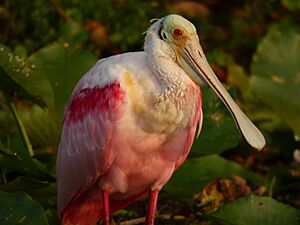 |
|
| At Orlando Wetlands Park,Orange County, Florida | |
| Conservation status | |
| Scientific classification | |
| Genus: |
Platalea
|
| Species: |
ajaja
|
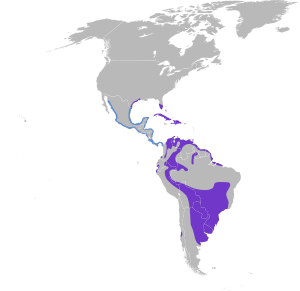 |
|
| Year-round Nonbreeding | |
| Synonyms | |
|
Ajaia ajaja (Linnaeus, 1758) |
|
The roseate spoonbill (Platalea ajaja) is a beautiful wading bird. It belongs to the same family as ibises and other spoonbills. You can find these birds living in both North and South America. Their amazing pink color comes from the food they eat. It's similar to how flamingos get their pink feathers!
Contents
Discovering the Roseate Spoonbill
Naming the Species
A long time ago, in 1758, a Swedish scientist named Carl Linnaeus officially described the roseate spoonbill. He gave it the scientific name Platalea ajaja. This name helps scientists around the world know exactly which bird they are talking about. Linnaeus learned about this bird from earlier descriptions by another naturalist, Georg Marcgrave. Marcgrave had called it "Aiaia" in his book about Brazil.
What Does the Name Mean?
The first part of its scientific name, Platalea, comes from Latin. It means "broad," which perfectly describes its wide, flat bill. The second part, ajaja, comes from the Tupi language. This was the name local people in Brazil used for the bird. Scientists agree that there is only one type of roseate spoonbill. There are no different subspecies.
Family Tree of Spoonbills
Scientists have studied the DNA of spoonbills to understand their family tree. A study in 2010 showed that the roseate spoonbill is closely related to the yellow-billed spoonbill. These two birds are like cousins to the other four spoonbill species. Even though some thought they could be in separate groups, scientists decided to keep all six spoonbill species in the same main group, Platalea. This is because they all look very similar.
What Does a Roseate Spoonbill Look Like?
Size and Shape
Roseate spoonbills are quite large birds. They can be about 71 to 86 centimeters (28 to 34 inches) long. Their wings can spread out to an impressive 120 to 133 centimeters (47 to 52 inches). An adult bird usually weighs between 1.2 and 1.8 kilograms (2.6 to 4 pounds). They have long legs, a long neck, and a very special bill.
Their Unique Pink Color
Adult spoonbills have a mostly deep pink body. Their head is bare and greenish, but it can look golden during breeding season. They also have a white neck, back, and chest. During breeding, a tuft of pink feathers appears on their chest. Their bill is grey and shaped like a spoon. Both male and female spoonbills look very similar.
How They Get Their Color
Just like American flamingos, roseate spoonbills get their pink color from their food. They eat tiny creatures that contain special pigments called carotenoids. These pigments, like canthaxanthin, turn their feathers pink. The shade of pink can change. It depends on the bird's age, if it's breeding, and where it lives. Their color can range from a light pink to a bright, vibrant magenta.
How They Fly
When spoonbills fly, they stretch their necks out straight. This is different from herons, which often fly with their necks pulled back. They fly by flapping their wings a few times, then gliding, and then flapping again.
Where Do Roseate Spoonbills Live?
Their Home Range
You can find roseate spoonbills in many places. They live in South America, mostly east of the Andes mountains. They also live along the coasts of the Caribbean, Central America, and Mexico. In the United States, they are common in Texas, Florida, and southwest Louisiana. They can be seen as far north as Myrtle Beach in South Carolina. This includes places like Merritt Island National Wildlife Refuge in Florida.
A Comeback Story
Long ago, in the 1700s and 1800s, people hunted these birds for their beautiful feathers. This practice, called plume hunting, almost made them disappear forever. Luckily, people started working to protect them. Thanks to these efforts and changes in the environment, their numbers have grown. They are now spreading to new areas in the 21st century.
Expanding Their Territory
For example, roseate spoonbills nested in Georgia for the first time in 2011. Their presence in South Carolina has also increased a lot since the 1970s. In 2023, a spoonbill was seen in Wisconsin for the first time in 178 years! This was a big surprise, as the last record was from 1845. In 2021, some birds were even spotted far north in places like Washington, D.C., upstate New York, and New Hampshire. A big group was seen in Huntley Meadows Park in Virginia. People in New Jersey are also seeing them more often.
Important Indicators
In Florida Bay, roseate spoonbills are like natural thermometers. Scientists watch them to understand the health of the environment. The number of nests changes depending on the amount of fresh water and the depth of the ocean water. This shows how wetlands are changing. Between 2006 and 2020, these birds started nesting more to the north and inland in Florida.
How Roseate Spoonbills Live
Finding Food
Roseate spoonbills are social birds, often feeding in groups. They like shallow fresh water or coastal areas. They walk slowly through the water, swinging their special spoon-shaped bill from side to side. This unique bill helps them sift through mud and catch small creatures.
What's on the Menu?
Their diet includes many small things. They eat crustaceans like shrimp, aquatic insects, and mollusks. They also enjoy tiny fish, frogs, and newts. Sometimes, they even eat small bits of plants. In Brazil, scientists found their diet includes fish, insects, crustaceans, mollusks, and seeds. They find all this food in freshwater areas.
Sharing the Feeding Grounds
Spoonbills sometimes share their feeding spots with other birds. They might compete for food with birds like snowy egrets and great egrets. Interestingly, egrets sometimes follow spoonbills. As the spoonbill stirs up the mud, it makes it easier for the egrets to find food. This is like a "beater-follower" team!
-
On High Island, Texas, United States
-
At GaiaZoo, Netherlands
-
Foraging roseate spoonbills at Merritt Island, Florida, United States
Reproduction and Life Cycle
Nests and Eggs
Roseate spoonbills build their nests in shrubs or trees. They often choose mangrove trees. A female spoonbill usually lays two to five eggs. These eggs are whitish with brown spots.
Young Spoonbills
When young spoonbills hatch, they look a bit different from adults. Their heads are white and covered in feathers. Their pink feathers are also much paler. Their bills are yellowish or pinkish. Sadly, sometimes young birds in the nest can be preyed upon by animals like turkey vultures, bald eagles, and raccoons. Even tiny fire ants can be a threat.
Protecting the Roseate Spoonbill
From Danger to Safety
As we learned, hunting for feathers almost made these birds disappear long ago. But thanks to many years of conservation work, the roseate spoonbill is now doing much better. Scientists currently consider them to be a species that is not threatened.
Long-Lived Birds
We don't know much about what preys on adult spoonbills. However, we do know they can live a long time! In 2022, scientists found a spoonbill that had a special band on its leg. This bird was 18 years old, making it the oldest wild roseate spoonbill ever recorded!
See also
 In Spanish: Espátula rosada para niños
In Spanish: Espátula rosada para niños



